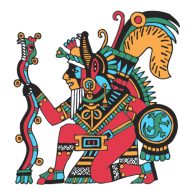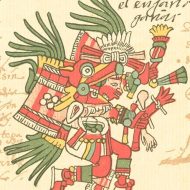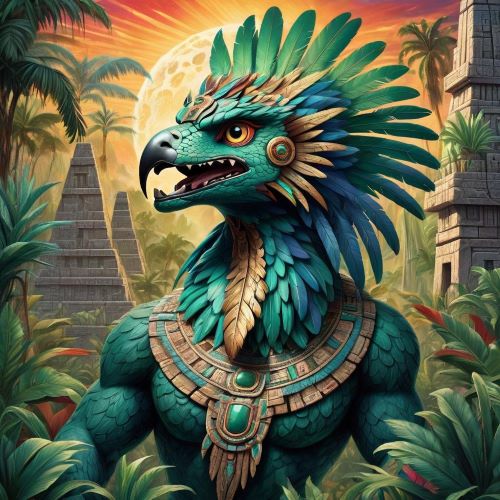Huehuecoyotl : The Trickster God
Listen
At a glance
| Description | |
|---|---|
| Origin | Aztec Mythology |
| Classification | Gods |
| Family Members | Tezcatlipoca (Father), Xochiquetzal (Wife) |
| Region | Mexico |
| Associated With | Shapeshifting, Mischief, Trickster |
Huehuecoyotl
Introduction
Huehuecoyotl, often identified as the “Ancient Drum” or the “Old Coyote,” holds a prominent position in Aztec mythology. Renowned for his association with music, dance, mischief, and song, he personifies the essence of joy and narrative. Additionally, he serves as the patron deity of unrestrained sexuality. More than merely a trickster figure, Huehuecoyotl encapsulates the dual nature of life, embodying both the unbridled joy of existence and its unpredictable twists and turns. In the intricate tapestry of Aztec cosmology, Huehuecoyotl stands as the divine embodiment of music, dance, mischief, and the perpetual cycle of life.
Physical Traits
Huehuecoyotl is commonly illustrated as a coyote engaged in dance, possessing human hands and feet, often accompanied by a human drummer. His name, translating to “very old coyote,” carries positive connotations for the Aztecs, symbolizing traits such as astuteness, worldly wisdom, pragmatism, male beauty, and youthfulness. The depictions of his darker side showcase a coyote appearance with non-human characteristics, adorned with black or yellow feathers that contrast the usual green plumage.
Visual representations of Huehuecoyotl often present a playful fusion of coyote and human attributes. Picture a slender, bipedal coyote adorned in a vibrant loincloth, showcasing nimble hands and feet. His mischievous grin reveals sharp teeth, while his eyes sparkle with a combination of cunning and humor. Some renditions feature him wearing a feathered headdress or wielding a rattle, further emphasizing his connection to the realms of music and dance.
The choice of the coyote as a representation holds significance, drawing from its reputation in Mesoamerican folklore as a clever and adaptable creature. This mirrors the trickster aspect of Huehuecoyotl’s persona, where his ability to navigate various realms and engage in mischievous exploits aligns with the cunning nature of the coyote in local tales.
Family
Huehuecoyotl is a member of the Tezcatlipoca (Smoky Mirror) family, belonging to the pantheon of Mexica gods and inheriting their remarkable shapeshifting abilities. Born to Omecihuatl and emerging through Tecpatl, Huehuecoyotl is part of a lineage with significant influence in Aztec mythology. Within this divine family, he is recognized as the son of Tezcatlipoca, a formidable deity associated with night, sorcery, and mirrors.
This familial connection bestows upon Huehuecoyotl inherited powers, including the extraordinary capacity for shapeshifting and the manipulation of fate. Notably, he is often paired with Xochiquetzal, the goddess revered for her domains of flowers, love, and beauty. This divine coupling adds further layers to Huehuecoyotl’s character, enriching his narrative within the intricate tapestry of Aztec cosmology.
In alternative perspectives, Huehuecoyotl is also considered among the progeny of the primordial god Ometeotl, a deity embodying the essential concept of duality and the balance of opposites. This lofty parentage places Huehuecoyotl in a distinguished position within the celestial hierarchy, emphasizing his connection to the fundamental forces shaping the universe.
Contrastingly, certain accounts identify him as a child of Tezcatlipoca, the god renowned for providence and sorcery. This alternative lineage further underscores Huehuecoyotl’s association with trickery and illusion, highlighting the complex and multifaceted nature of his divine character.
Despite his illustrious divine lineage, Huehuecoyotl is frequently depicted as a solitary figure, navigating various realms and engaging in mischievous exploits. This portrayal underscores his independence and penchant for unpredictable adventures, solidifying his role as a trickster god within the expansive pantheon of Aztec mythology.
Other names
Apart from being recognized as Huehuecoyotl, this deity is also acknowledged by the alternative name Ueuecoyotl. Additionally, alternative designations include “Ancient-Drum” and “Old-Old-Coyote.” The appellation “Very Old Coyote” encompasses a range of monikers, each shedding light on different aspects of this deity’s intricate character. Referred to as Ueuecoyotl at times, his age and wisdom take center stage. The name “Old Man Fire” underscores his connection to transformation and creation, while “Laughing Coyote” highlights his inclination for pranks and festive revelry.
Powers and Abilities
Huehuecoyotl possesses a diverse array of powers and attributes, revered as the deity presiding over narration, music, dance, and joy. Among his distinctive qualities is the gift of shape-shifting, a trait shared with the Tezcatlipoca family of gods. Known for his mischievous disposition, Huehuecoyotl frequently engages in playful pranks that impact both divine beings and mortals alike. Additionally, he holds the esteemed position as the patron of uninhibited sexuality, embracing partnerships with individuals of any gender or species.
However, Huehuecoyotl’s capabilities extend beyond mere mischief. His mastery of shape-shifting enables him to transform into any creature or object at will. Proficient in manipulating fire, he can breathe life into inanimate things and serve as a catalyst for change. Endowed with a keen intellect, Huehuecoyotl excels in devising intricate plots, outsmarting even the most astute gods.
Yet, perhaps his most formidable power lies in his influence over chance and fate. Through a combination of trickery and wit, Huehuecoyotl can alter the course of events, steering both mortals and gods towards unforeseen destinies. As the god of music and dance, he holds the ability to inspire artistic expression and creativity. The rhythmic beats of drums, the melodic tones of flutes, and the dynamic movements of dance are all associated with him. In Aztec rituals and ceremonies, devotees sought his favor to ensure the success of their artistic performances, invoking a profound sense of joy and celebration. Huehuecoyotl’s multifaceted powers contribute to his status as a dynamic and influential deity within Aztec mythology.
Modern Day Influence
Huehuecoyotl’s impact transcends the confines of ancient mythology, seamlessly weaving into the fabric of modern culture. The enigmatic allure of his mystical persona has been skillfully incorporated into the works of poets and storytellers, capturing the very essence of his cunning and trickery. As a trickster coyote deeply embedded in cultural beliefs, Huehuecoyotl continues to enthrall audiences with his crafty schemes and playful antics.
Though the Aztec empire has become a chapter in history, Huehuecoyotl’s vibrant spirit perseveres. His enduring influence permeates various artistic mediums, from literature and paintings to contemporary performance art. Indigenous communities in Mexico and beyond maintain a sense of reverence for him, acknowledging his embodiment of resilience and adaptability in the face of challenges. Furthermore, his themes of duality and the acceptance of both shadows and light strike a chord with modern audiences grappling with intricate realities.
Huehuecoyotl stands as a poignant reminder that life is not a linear tale but rather an unpredictable dance between order and chaos, creation and destruction. His laughter reverberates through time, urging us to embrace the absurdity and marvel of existence, to find joy in the unexpected twists and turns that life presents. In the timeless dance of existence, we are encouraged to mirror the spirit of the “Very Old Coyote” and engage in the rhythmic dance of life itself.
Related Images
Frequently Asked Questions
What is lorem Ipsum?
I am text block. Click edit button to change this text. Lorem ipsum dolor sit amet, consectetur adipiscing elit. Ut elit tellus, luctus nec ullamcorper mattis, pulvinar dapibus leo.
What is lorem Ipsum?
I am text block. Click edit button to change this text. Lorem ipsum dolor sit amet, consectetur adipiscing elit. Ut elit tellus, luctus nec ullamcorper mattis, pulvinar dapibus leo.
What is lorem Ipsum?
I am text block. Click edit button to change this text. Lorem ipsum dolor sit amet, consectetur adipiscing elit. Ut elit tellus, luctus nec ullamcorper mattis, pulvinar dapibus leo.
What is lorem Ipsum?
I am text block. Click edit button to change this text. Lorem ipsum dolor sit amet, consectetur adipiscing elit. Ut elit tellus, luctus nec ullamcorper mattis, pulvinar dapibus leo.
What is lorem Ipsum?
I am text block. Click edit button to change this text. Lorem ipsum dolor sit amet, consectetur adipiscing elit. Ut elit tellus, luctus nec ullamcorper mattis, pulvinar dapibus leo.












